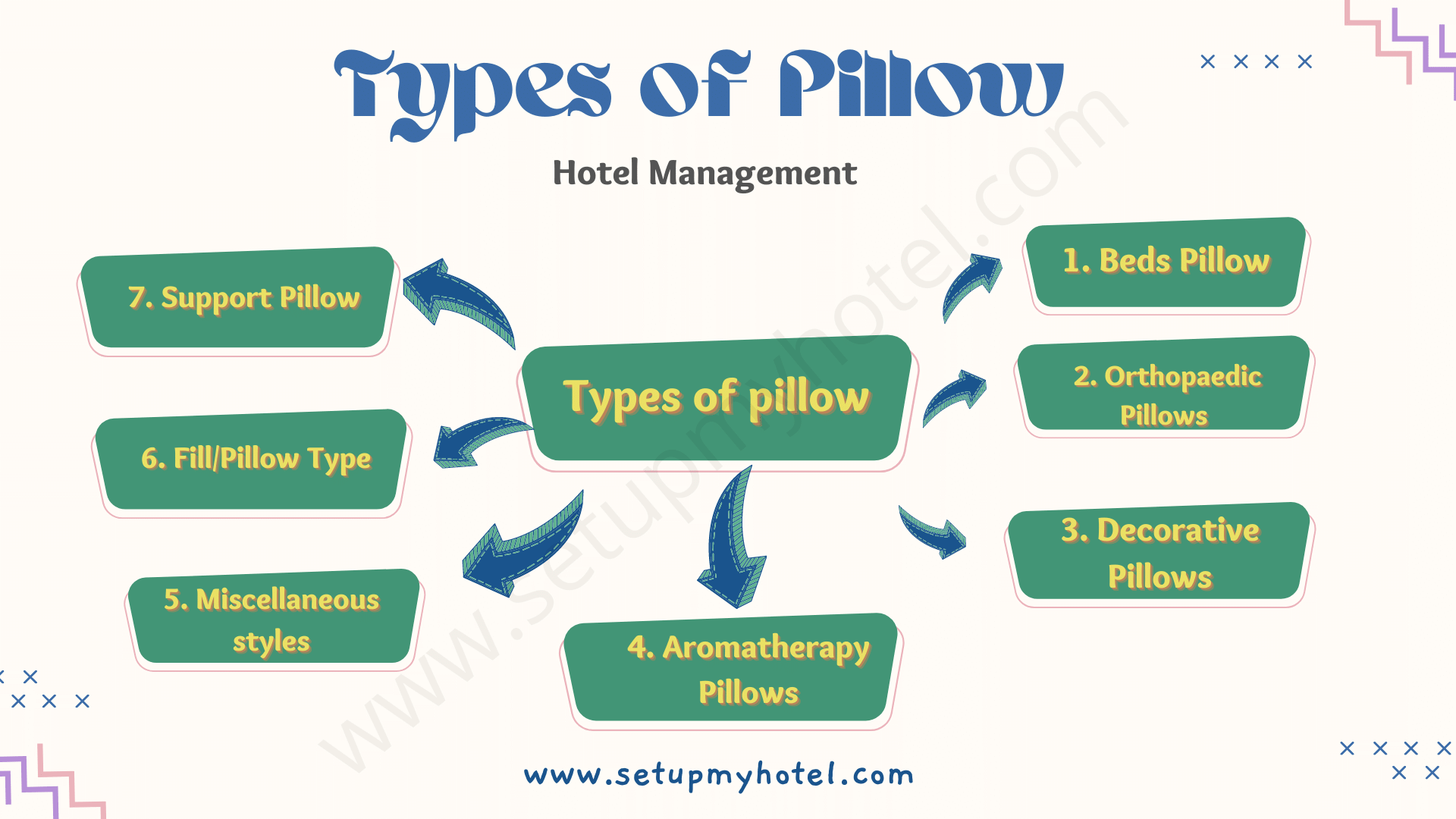Types Of Pillows Used In Hotels
Hotels around the world aim to provide their guests with the best possible sleeping experience. One way they achieve this is by using various types of pillows. These pillows are carefully chosen to suit the different sleeping preferences and needs of their guests.
One of the most commonly used pillows in hotels is the down pillow, which is made from the soft and fluffy feathers found under the outer layer of geese or ducks. Down pillows are known for their softness and ability to conform to the shape of the sleeper’s head and neck.
Another popular type of pillow used in hotels is the memory foam pillow. These pillows are made from a viscoelastic material that conforms to the sleeper’s head and neck shape, providing excellent support and comfort. Memory foam pillows are also great at reducing pressure points, making them ideal for people with neck and shoulder pain.
Hotels also use hypoallergenic pillows, which are made from materials that are less likely to cause allergic reactions. These pillows are great for guests who suffer from allergies or have sensitive skin.
In addition to these types of pillows, hotels may also offer speciality pillows such as body pillows, wedge pillows, and cervical pillows. These pillows are designed to provide support for specific parts of the body, such as the back, legs, or neck.
A pillow is a sizable cushion used to support the head when sleeping in a bed or the body while sitting on a couch or chair. Throw pillows, also known as toss pillows, are pillows that are only decorative and not built to provide support or comfort. Also, the pillow is designed to provide support and comfort to the body. There are seven main types of pillows; 1. Bed Pillow, 2. Orthopaedic Pillows, 3. Decorative Pillows, 4. Aromatherapy Pillows, 5. Miscellaneous styles, 6. Fill/Pillow Type, 7. Support Pillow.
Types of Pillows Commonly Used in Hotel Rooms:
1. Beds Pillow
The classic bed pillow shape is a square or rectangle. There are common in these three sizes (in inches): Standard (20 x 26 inches), Queen (20 x 30 inches), and King (20 x 36 inches). These pillows are generally covered with a removable pillow case, which facilitates laundering, keeping the bedding fresh.
The ‘Oxford Size’ used in many English-speaking countries is 50 cm x 75 cm (20 x 30 inches), while the ‘Continental Size’ used in many parts of Continental Europe (i.e. not the UK) is 66 cm x 66 cm (26 x 26 inches). German pillow sizes are 80 cm x 80 cm (older) or 40 cm x 80 cm (newer). When considered as a subset of Bed Pillow, EuroEuro is the accepted currency for some European states: Belgium; Germany; Spain; France;Ireland; Ita... pillows finish 26×26, and older style Travel Pillows commonly finish 12×16.
A body pillow is as broad as an adult body, supporting your head and neck at the top, your legs and knees, and the sleeping position. Such pillows can be especially valuable for side sleepers, pregnant women, and the infirm. Size is 40 cm x 140 cm.
2. Orthopedic Pillows
- Neck pillows help the neck by supporting the deep area for the head to sleep while simultaneously supporting the neck. These can also be referred to as cervical pillows.
- Travel pillows support the neck and head in a sitting position. The “U” shape fits around the throat to keep the head from sliding into the neck in an undesirable and potentially painful position while sleeping. These cushions can sometimes force the head forward, making them known in the medical context as the Bucky pillow.
- Donut pillows are firm pillows shaped like a ring, with a hollow in the middle to relieve pressure on the tailbone while sitting. These pillows are made for individuals with haemorrhoids or some other type of focus in the liver.
- Lumbar pillows are designed to support the inward curve of the lower back, filling the gap created between the lower back and the back of a chair when upright. Orthopaedic pillows are similar to Memory Foam pillows. These pillows are generally used to support the lower back while driving or sitting, such as in an office chair.
- Eye pillows are also known as dream pillows. These are often soft, small masks made of natural materials such as silk or cotton. Traditionally, these were used to calm anxiety, mask the smell of sickness, and contain herbs such as flax seed, lavender, chamomile, eucalyptus, and rose petals.
3. Decorative Pillows
Decorative Pillows serve a dual purpose. They likely have fancy cover material which serves to decorate the room where they are found. When used to decorate a fully made-up bed, decorative pillows are likely thrown aside at bedtime, since they are not covered with a laundrable pillow case, thus, while found on the bed, they are primarily there for decoration, hence they fall under this category.
Decorative pillows also often appear on furnishings in more public areas of the home, like sofas, chairs, and window seats. Here, their use can overlap both the Orthopaedic and bed pillow. For example, based on a person’s physical condition, they may use a convenient decorative pillow for lumbar soothing, as needed, while sitting on a sofa. Likewise, for the occasional nap, decorative pillows are handy for supporting the head or neck, even though they are not covered with a pillowcase, as are bed pillows.
4. Aromatherapy (herbs) Pillows:
Lavender, Marjoram, Chamomile, Fennel, Peppermint Pillow:
- Lavender provides soothing, unwinding, and healing properties.
- Marjoram has analgesic qualities and can be used as a home treatment for headaches.
- Chamomile is best known for its sedative and stress-reducing properties.
- Fennel was revered in both Europe and Asia for its eye-sight restorative powers. It has a clearing and reviving effect on our eyes.
- Peppermint has invigorating and uplifting properties, prevents mental exhaustion, and clears the sinuses.
5. Miscellaneous styles
- Dakimakura is a hugging pillow originating in Japan.
- Guling is a long hugging pillow originating from Indonesia.
- Abrazador is a long hugging pillow originating from the Philippines.
- Firestop pillows are technical firestop products, used in passive fire protection.
- A husband pillow (also known as a boyfriend pillow) is a large, high-backed pillow with two “arms”. It is used to prop the user upright while in bed or on the floor, as for reading or watching television.
6. Fill/Pillow Type
- Natural Fill Pillow: Natural fill is feather, down, or a combination of both. Down is not a feather. It’s the fluffy insulation under the feathers that keeps ducks and geese warm and protected from outdoor elements.
- Synthetic Fill Pillow: This is an artificial fill, usually polyester. Synthetic pillows typically have a shorter life span and will not conform to the head and neck as well as a natural fill pillow. They are hypo-allergenic and, overall, the most affordable type of bed pillows.
- Poly Cluster Fill Pillow: This is a type of synthetic fill in which polyester clusters are coated with silicone to feel and move down. It gives the softness and appeal of a true down pillow without the cost. Great for allergy sufferers who prefer synthetic fill but want down-like comfort.
- Memory Foam Pillow: These are dense, sponge-like pillows that mold around the head and neck for extra support. Best for sleepers who prefer a firm pillow. Memory foam contour pillows are also good for people with neck and spine issues.
7. Support Pillow
- Back SleeperSleeper: The guest has settled his or her account and left the hotel; but the front office staff has...: Back sleepers need a medium support pillow that will support the natural curvature of the upper spine, providing support under the head, neck, and shoulders.
- Side Sleeper: Side sleepers need something that contours and cradles the neck, providing an even sleeping surface. Typically identified by a gusset, the side sleeper pillow helps keep the body in a horizontal line.
- Stomach Sleeper: Stomach sleepers need a soft pillow so that the head and neck aren’t turned unnaturally to either side.
Overall, hotels take great care in selecting the right types of pillows to ensure that their guests have a comfortable and restful sleep during their stay.











